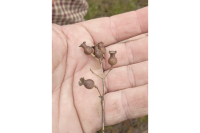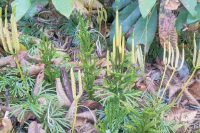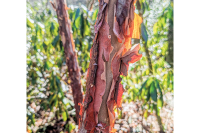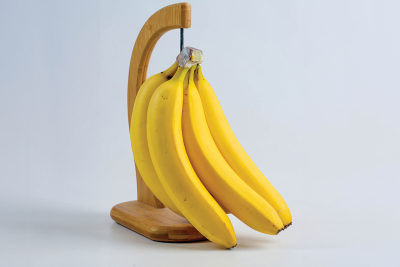The birders… they are a’changing: A new generation of birders rises up
I’ve been birding in Western North Carolina since I got here in the late 1980s, in my mid-thirties (yes, I’m that old.)
When I would show up for a birding trip or program, I would be one of the “youngsters.” I kept birding and kept attending events and the constant thing was, we all kept getting older. I have participated in the Balsam Christmas Bird Count since its inception in 2003, and trust me, to see a face under 50 years of age is a novelty.
Scarlet tanagers spar in song
This seems to be a scarlet tanager kind of year. I’ve been seeing and hearing them at my house, along the Blue Ridge Parkway, and in the Great Smokies. No bird in our region is more striking. Jet black wings on a trim red almost luminescent body, the male is impossible to overlook. And it’s easy to recognize by both song and call.
The secretive, intelligent and prolific crow
Like most commonly observed objects, crows flit across our field of vision unheeded. Caw-caw-cawing unmusically … flap-flap-flapping over the fields … dressed as if for a funeral … iridescent pieces of black flannel waving in the breeze. We hear and see them … but we don’t really pay attention. We rarely think about them … we never ask ourselves: “What are these birds up to?”
Observing birds is a habit that never grows old
Lately, I’ve been writing a lot about birds. I guess I have them on my mind, in part, because the spring migration season is underway. I heard my first Louisiana waterthrush (a warbler) of the year this past Sunday morning. But then again, birds are always on my mind summer, fall, and winter, too. And I’m not alone. Each week that I write about birds, I receive at least 10 emails from readers who share their bird observations and insights with me. Here we go again.
The Naturalist's Corner: Snowbirds part deaux
In a past column regarding snowbirds (“Snowbirds are here”), I wrote, “No, I’m not talking about your Uncle Bernie and Aunt Esther from New York City.” But I recently learned snowbirds (dark-eyed juncos) are kinda like your northern relatives — they like to come back to the same spot each winter. It seems many of the snowbirds at your feeders this winter were probably there last winter. And like relatives, we get used to them being around.
The Naturalist's Corner: CBC vagaries
This year’s Balsam Christmas Bird Count was record setting — but maybe not in a good way. The 63 species recorded was the lowest total in the count’s 17-year history. Next lowest counts were 65 species (two times) and 66 species once. The average number of species for the count is 70.
The Naturalist's Corner: Guilty pleasure
Last Saturday, Dec. 7, had the makings of a very productive day. Girls were going to Asheville shopping and home would be calm and quite. There was no shortage of correspondence to catch up on — trying to nail down the last particulars of our annual Balsam Christmas Bird Count (CBC), try to figure out how to merge my email accounts (geek I’m not) as my old Bellsouth email had been hacked and I switched over to Gmail, plus enough “honey dos” to last the rest of the year.
The Naturalist's Corner: The A, B, C and Ds of chickadees
All birders, backyard feeders and most other people know chickadees. These small, noisy, gregarious black and gray fluff balls are found in nearly any habitat, from the deepest wilderness area to urban parks and streets. There are seven North American species of chickadees, Carolina chickadee, Poecile carolinensis, black-capped chickadee, P. atricapillus, boreal chickadee, P. hudsonicus, chestnut-backed chickadee, P. rufescens, grey-headed chickadee, P. cinctus, mountain chickadee, P. gambeli and Mexican chickadee, P. sclateri.
The Naturalist's Corner: Louisiana solitude
I recently made a semi-regular sojourn to the northeast Louisiana Delta, a stone’s throw from where I grew up. Friends get together twice a year (spring and fall) for a cookout at a beautiful spot along the Ouachita River. It is hard for me to tear away in the spring so I usually shoot for fall. I don’t make all of them, but I make as many as I can. It’s so good to see old friends and make new ones in such a relaxed atmosphere. This trip provided an extra bonus as I got to share a reading from A Year from the Naturalist’s Corner Volume I at Black Bayou Lake National Wildlife Refuge’s visitor center. Thanks to Friends of Black Bayou and BBLNWR staff for making that happen.
The Naturalist's Corner: Santee surprise
During our annual summer beach trip to Isle of Palms, I often manage to sneak away one morning to visit Santee Coastal Reserve for an annual red-cockaded woodpecker fix. State and federal agencies have been successfully enhancing the endangered red-cockaded woodpecker population at Santee Coastal for a number of years. It’s a great place to see these noisy little woodpeckers as they nest along the main dirt road through the reserve and all you have to do is drive slowly along until you hear the constant chatter of a colony.









